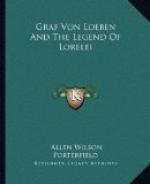[40] In Pissin’s collection of Loeben’s
poems (D.L.D., No. 135)
we have a peculiar note.
After the ballad (Anmerk.,
p. 161), which Pissin entitles
“Der Lurleifels,” we read:
“N.d. Hs.”
This would argue that Loeben did so entitle his ballad
and that Pissin had access
to the original MS. But then Pissin
says: “Auch, die
gleichnamige Novelle einleitend, in der
Urania auf 1821.”
But in Urania the novelette is
entitled “Eine Sage
vom Rhein.” and the ballad is entitled
“Loreley.”
Bet him who can unravel this!
[41] For the entire story of the composition and publication
of the
RheinmAerchen, see
Die MAerchen von Clemens Brentano,
edited by Guido GOerres. 2
vols. in 1, Stuttgart, 1879 (2d ed.)
This edition contains the
preface to the original edition of 1840,
pp. i-1.
[42] Thorn, who drew on M.R. Hewelcke’s
Die Loreleisage,
Paderborn, 1908, makes (p.
90) this suggestion. It is impossible
for the writer to see how
Thorn can be so positive in regard to
Brentano’s influence
on Heine. And one’s faith is shaken by this
sentence on the same page:
“Brentano verOeffentlichte sein
Radlauf-MAerchen erst
1827, Heine ‘Die Lorelei’ schon 1826.”
Both of these dates are incorrect.
Guido GOerres, who must be
considered a final authority
on this matter, says that, though
Brentano tried to publish
his MAerchen as early as 1816,
none of them were published
until 1846, except extracts from “Das
MyrtenfrAeulein,” and
a version of “Gockel,” neither of which
bears
directly on the Lorelei-matter.
[43] Of GOerres’ second edition, I, 250:
“Nachdem Murmelthier herzlich
fUer diese Geschenke gedankt
hatte, sagte Frau Else: ’Nun, mein
Kind! kAemme mir und Frau
Lurley die Haare, wir wollen die deinigen
dann auch kAemmen’—dann
gab sie ihr einen goldnen Kamm, und
Murmelthier kAemmte Beiden
die Haare und flocht sie so schOen, dass
die Wasserfrauen sehr zufrieden
mit ihr waren.”
[44] In H. Heines Leben und Werke.
Hamburg, 1884 (3d ed.),
Bd. I. p. 363. In
the notes, Strodtmann reprints Loeben’s ballad,
pp. 696-97. His statement
is especially unsatisfactory in view of
the fact that he refers to
the “fast gleicher Inhalt,” though the
essentials of Heine’s
ballad are not in Loeben’s, and to
“einegewisse AEhnlichkeit
in Form,” though the similarity in form
is most pronounced.
[45] In Allgemeine deut. Biog., XIX. 44.
It is interesting to
see how Professor Muncker
lays stress on this matter by placing in
parentheses the statement:
“Einige ZUege der letzten Geschichte
["Sage vom Rhein”] regten
Heine zu seinem bekannten Liede an.”




